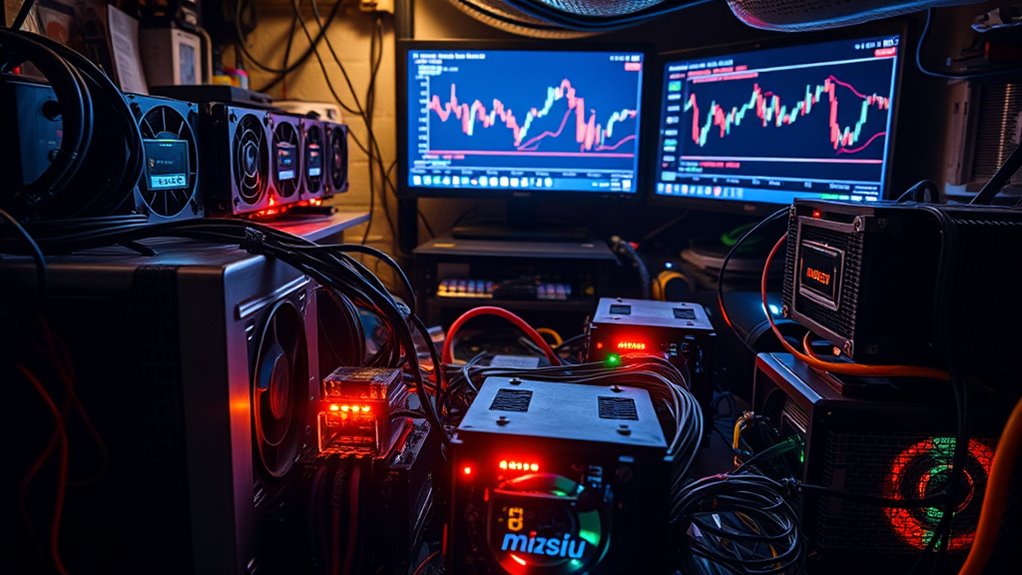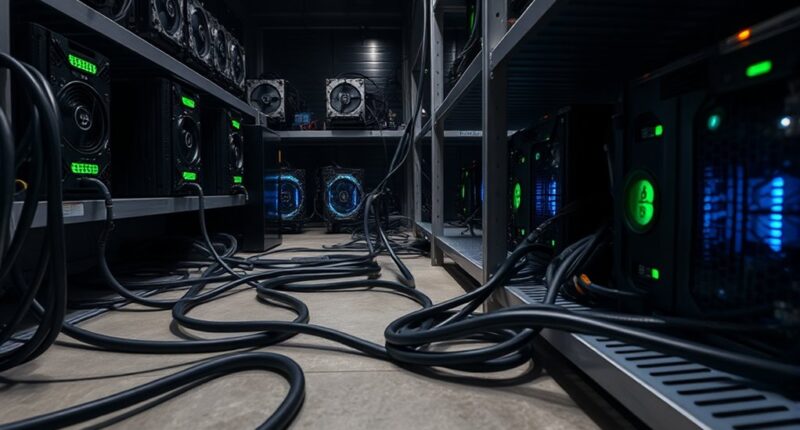After a halving, staying profitable with small rigs means optimizing your energy use by switching to renewable sources like solar or wind, which lowers your electricity costs. Upgrading your hardware for better efficiency and faster output also helps compensate for reduced rewards. Choosing locations near renewable resources can give you a cost edge. Staying flexible with pools and diversifying your crypto portfolio further stabilizes your income. Keep exploring these strategies to maximize your mining successes post-halving.
Key Takeaways
- Upgrade to energy-efficient hardware with higher hashrate-to-power ratios for better profitability.
- Utilize renewable energy sources like solar or wind to reduce electricity costs significantly.
- Join mining pools powered by renewable energy to stabilize income and share rewards.
- Optimize hardware settings, such as overclocking safely and improving cooling, to maximize output.
- Choose strategic locations near renewable energy hubs to lower operational costs and enhance sustainability.

After a halving event, miners face a new economic landscape where block rewards decrease, making it more challenging to sustain profitability. For small-scale miners, this shift demands strategic adjustments to stay competitive. One of the most effective ways to do this is by integrating renewable energy sources into your mining operations. Renewable energy, such as solar or wind, can markedly reduce your electricity costs, which is often the largest expense in mining. By harnessing cleaner, cheaper energy, you can improve your profit margins even when rewards are halved. This approach not only cuts costs but also aligns your mining activity with sustainable practices, which can be appealing to eco-conscious investors and communities.
Integrate renewable energy to lower costs and boost profits after halving events.
Equally important is upgrading or optimizing your mining hardware. As block rewards decrease, efficiency becomes critical. Investing in more energy-efficient mining hardware allows you to get the most out of your electricity consumption, producing more hashes per watt. Smaller rigs, in particular, benefit from hardware that is optimized for lower energy use while maintaining competitive hashrates. Look for miners with higher hashrate-to-power ratios and consider hardware that supports overclocking safely to maximize output without drastically increasing power consumption. Maintaining and properly cooling your mining hardware can also extend its lifespan and ensure consistent performance, further protecting your investment against the reduced income from block rewards. Additionally, understanding the importance of contrast ratio can help you choose the right equipment and setup to optimize visibility and efficiency in your mining environment.
Additionally, you should consider the location of your mining setup. Choosing a place with access to renewable energy sources—such as regions with abundant sunshine or strong winds—can give you a cost advantage over competitors relying on traditional power grids. Some small miners have moved or expanded their operations to areas where renewable energy is plentiful and cheaper, enhancing overall profitability. This requires some initial investment and planning but can pay off in the long term, especially as halving events become more common and competitive pressures grow.
Finally, diversifying your approach by combining different cryptocurrencies or mining pools can help mitigate risks associated with halving events. Smaller miners often find it advantageous to join pools that use renewable energy or prioritize lower-cost electricity, ensuring a steady income stream even when rewards shrink. Staying adaptable and continuously optimizing your hardware, energy sources, and operational strategies will be key to maintaining profitability in the post-halving landscape. With careful planning, small rigs can still thrive by leveraging renewable energy and efficient mining hardware, turning challenges into opportunities for sustainable growth.
Frequently Asked Questions
How Does Post-Halving Affect Small Rig Profitability Over Time?
You wonder how halving impact influences small rig profitability trends over time. After halving events, block rewards decrease, which can cut into your earnings. To stay profitable, you need to optimize your operations, such as reducing energy costs or upgrading hardware. In the long run, small rigs might face tighter margins, but strategic adjustments can help you adapt and maintain profitability despite the halving impact.
What Are the Best Strategies for Small Miners Post-Halving?
You should focus on optimizing energy efficiency and choosing the right pool to stay profitable. Upgrading to energy-efficient hardware reduces costs, while selecting a reliable mining pool helps you earn consistent rewards. Keep an eye on electricity rates and consider joining pools with lower fees or better payout structures. By refining these strategies, you can maximize your small rig’s profitability even after halving events.
How Can Small Miners Reduce Operational Costs After Halving?
To reduce operational costs, focus on improving energy efficiency by upgrading your hardware or optimizing power usage. Additionally, choose your mining pool carefully—select a pool with low fees and reliable payouts to maximize profits. Regularly monitor your rig’s performance, adjust settings for efficiency, and consider negotiating better electricity rates if possible. These steps help small miners stay competitive and profitable in a challenging mining environment.
Are There Specific Coins More Profitable for Small Miners Post-Halving?
You should focus on coins that maximize your mining pool selection and energy efficiency. Coins like Litecoin or smaller altcoins often require less power and can be more profitable with small rigs. By choosing the right pool and optimizing energy use, you increase your chances of staying profitable after halving. Research coins with lower difficulty and better reward structures to make the most of your equipment.
What Hardware Upgrades Maximize Small Rig Profitability After Halving?
To maximize your small rig profitability, focus on upgrading mining software for better optimization and stability. Investing in hardware with higher power efficiency, like newer ASICs or GPUs, reduces energy costs and boosts returns. Regularly update drivers and firmware to improve performance. By combining efficient hardware with optimized mining software, you guarantee your rig stays competitive and profitable, especially after halving events that cut rewards.
Conclusion
After the halving, staying profitable with small rigs requires staying efficient and adaptable. Keep an eye on your costs, optimize your setup regularly, and consider joining mining pools to boost your chances. Don’t be discouraged by the increased competition; instead, look for ways to maximize your hardware’s potential. With careful management and a bit of persistence, you can continue mining successfully even in this new, challenging landscape.





